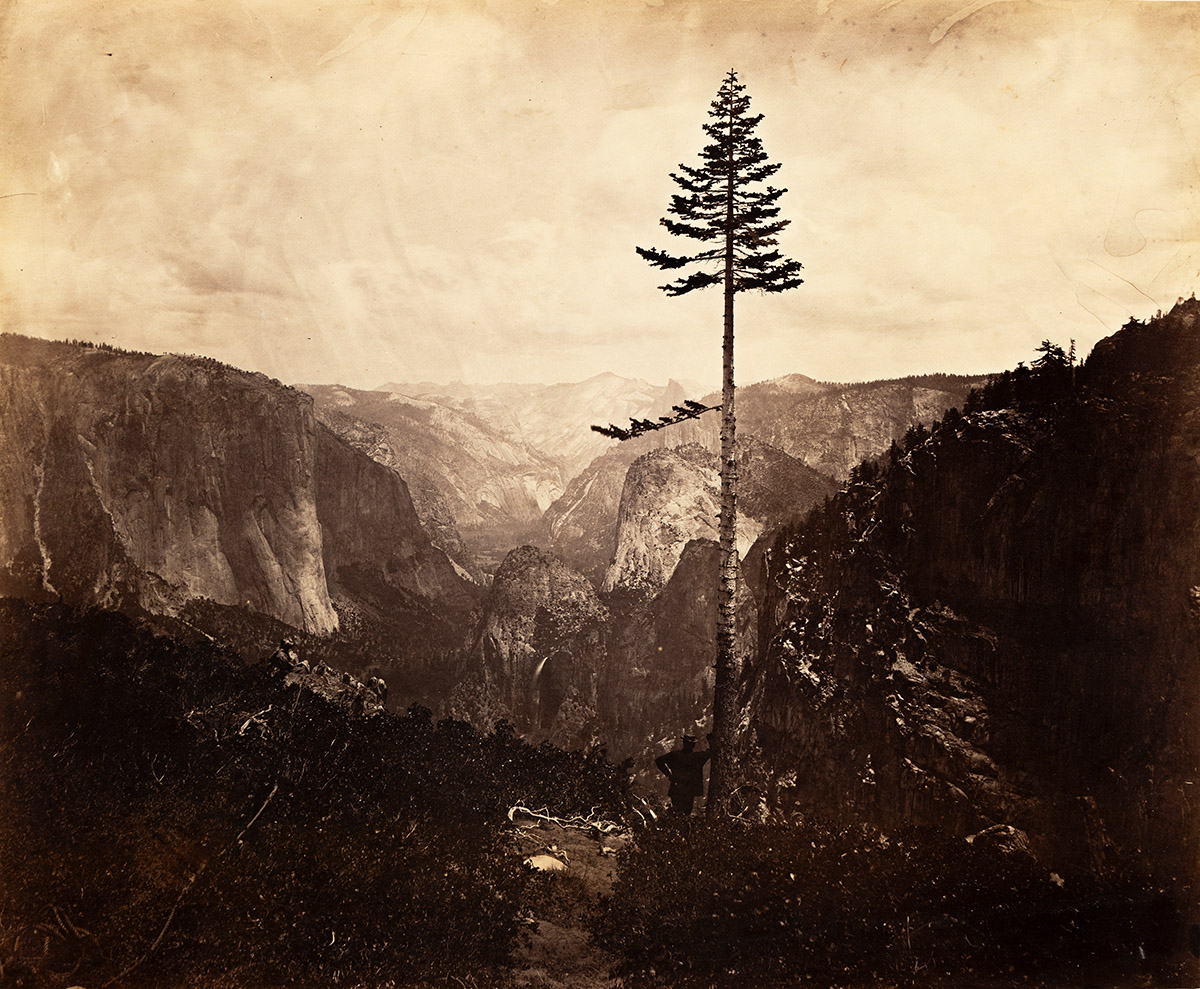Sale 2684 - Lot 7
Unsold
Estimate: $ 12,000 - $ 18,000
CHARLES LEANDER WEED (1824-1903)
Yosemite Valley from the Mariposa Trail. 1864; printed no later than 1867.
Mammoth albumen print, the image measuring 17⅛x20¾ inches (43.5x52.7 cm.), the mount 19¾x23½ inches (50.2x59.7 cm.), with the publisher's Lawrence & Houseworth printed credit, San Francisco address, and title on mount recto, and the publisher's letterpress "Photographic Views of California Scenery" label on mount verso.
Provenance
A California Collection
Weed is widely believed to have been the first photographer to work in Yosemite, and his 1859 trip there, made under the auspices of publisher and Yosemite promoter James Mason Hutchings, yielded approximately twenty 10x14-inch views and forty stereo images. For his 1864 photographic expedition to the Valley, Weed was equipped with a larger camera and larger glass plates and was able to produce the impressive mammoth-plate print offered here, in addition to a new series of stereo views. It was these 1864 images that won the first-place bronze medal at the 1867 Paris International Exhibition. This mammoth albumen print is one of the earliest and most iconic photographs of Yosemite Valley, reminiscent of Caspar David Friedrich's masterpiece painting, "Wanderer above the Sea of Fog," 1818.
Weed began his association with the publishers Lawrence & Houseworth in 1864 and contracted with them to produce large images of Yosemite and adjacent areas. By 1866, the firm listed his mammoth-plate photographs for sale in their catalogue, as follows: "Yosemite Valley and Big Tree Views, Negatives by C. L. Weed, Size 22 by 28 inches." In 1870 the publishers still listed Weed's photographs, but without his attribution.
Born in New York State, Weed moved first to Wisconsin with his family and then to California, where he was associated with the daguerreotypist George W. Watson in Sacramento and then with Robert Vance. It was while he worked for Vance that Weed learned the wet-plate process, and his 1859 Yosemite photographs were made with this new method. In 1860, Weed made his first trip to Asia, photographing and briefly opening at studio in Hong Kong and Canton. By the time he returned to San Francisco in 1864, he was a more skilled photographer. He would go on to make images in Japan and Hawaii in addition to China.
The difficulties of making mammoth-plate negatives on glass in Yosemite's wilderness were considerable: wind, dust, heat, altitude, and the lack of water made the execution of an acceptable negative extraordinarily difficult. Weed overcame these obstacles to produce images that are not only technically proficient, but aesthetically sophisticated renderings of the Yosemite landscape. Here, Weed's composition conveys both the romantic splendor of the Yosemite Valley as well as its vast beauty.
Yosemite Valley from the Mariposa Trail. 1864; printed no later than 1867.
Mammoth albumen print, the image measuring 17⅛x20¾ inches (43.5x52.7 cm.), the mount 19¾x23½ inches (50.2x59.7 cm.), with the publisher's Lawrence & Houseworth printed credit, San Francisco address, and title on mount recto, and the publisher's letterpress "Photographic Views of California Scenery" label on mount verso.
Provenance
A California Collection
Weed is widely believed to have been the first photographer to work in Yosemite, and his 1859 trip there, made under the auspices of publisher and Yosemite promoter James Mason Hutchings, yielded approximately twenty 10x14-inch views and forty stereo images. For his 1864 photographic expedition to the Valley, Weed was equipped with a larger camera and larger glass plates and was able to produce the impressive mammoth-plate print offered here, in addition to a new series of stereo views. It was these 1864 images that won the first-place bronze medal at the 1867 Paris International Exhibition. This mammoth albumen print is one of the earliest and most iconic photographs of Yosemite Valley, reminiscent of Caspar David Friedrich's masterpiece painting, "Wanderer above the Sea of Fog," 1818.
Weed began his association with the publishers Lawrence & Houseworth in 1864 and contracted with them to produce large images of Yosemite and adjacent areas. By 1866, the firm listed his mammoth-plate photographs for sale in their catalogue, as follows: "Yosemite Valley and Big Tree Views, Negatives by C. L. Weed, Size 22 by 28 inches." In 1870 the publishers still listed Weed's photographs, but without his attribution.
Born in New York State, Weed moved first to Wisconsin with his family and then to California, where he was associated with the daguerreotypist George W. Watson in Sacramento and then with Robert Vance. It was while he worked for Vance that Weed learned the wet-plate process, and his 1859 Yosemite photographs were made with this new method. In 1860, Weed made his first trip to Asia, photographing and briefly opening at studio in Hong Kong and Canton. By the time he returned to San Francisco in 1864, he was a more skilled photographer. He would go on to make images in Japan and Hawaii in addition to China.
The difficulties of making mammoth-plate negatives on glass in Yosemite's wilderness were considerable: wind, dust, heat, altitude, and the lack of water made the execution of an acceptable negative extraordinarily difficult. Weed overcame these obstacles to produce images that are not only technically proficient, but aesthetically sophisticated renderings of the Yosemite landscape. Here, Weed's composition conveys both the romantic splendor of the Yosemite Valley as well as its vast beauty.

Exhibition Hours
Exhibition Hours
Aliquam vulputate ornare congue. Vestibulum maximus, libero in placerat faucibus, risus nisl molestie massa, ut maximus metus lectus vel lorem.


